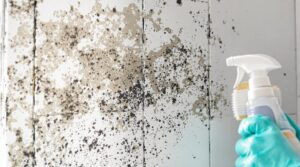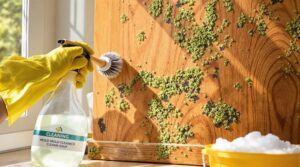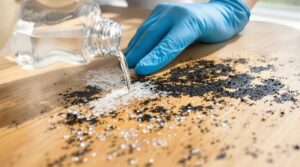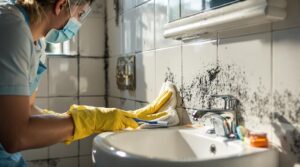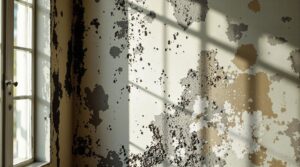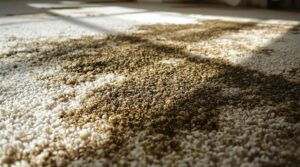Household mold removal requires choosing between natural and chemical solutions based on infestation severity. Natural methods like white vinegar and tea tree oil work effectively on small areas but may need multiple applications. Chemical treatments containing quaternary ammonium compounds provide faster results for extensive growth but require proper ventilation and safety equipment. Both approaches demand protective gear and systematic application techniques. Professional consultation becomes essential when mold covers large areas or health symptoms persist, leading to thorough remediation strategies.
Key Takeaways
- Natural solutions like white vinegar are safer but may require multiple applications, while chemical treatments provide faster results for severe infestations.
- Chemical cleaners containing quaternary ammonium compounds effectively eliminate mold but can cause material damage and skin irritation.
- Hard surfaces respond well to both natural and chemical treatments, while porous materials often require complete replacement.
- Proper ventilation and protective equipment are essential regardless of choosing natural or chemical mold removal methods.
- Address underlying moisture issues through dehumidifiers and proper ventilation to prevent mold regrowth after treatment.
Understanding the Dangers of Household Mold
Household mold presents significant health risks that warrant immediate attention and proper management. Common indoor species like Cladosporium, Penicillium, and Aspergillus can trigger various health symptoms, ranging from allergic reactions to more severe respiratory complications. While not all mold species are dangerous, prolonged exposure can lead to serious health issues.
The impact of mold exposure manifests through both immediate and long-term health effects. Short-term symptoms include hay fever-like reactions such as sneezing, runny nose, and skin rash.
More concerning are the long-term consequences, including cognitive impairment, memory loss, and increased risk of asthma development, particularly in infants and children. Research indicates that children living in mold-affected homes face triple the risk of developing asthma by age seven.
Effective mold prevention strategies begin with controlling moisture levels, maintaining humidity below 50%, and addressing water damage within 24-48 hours. Understanding these risks emphasizes the vital need for prompt mold remediation and prevention measures. Standard homeowners insurance policies typically provide between $1,000 to $10,000 in coverage for mold damage resulting from sudden, accidental water events.
Natural vs. Chemical Methods: A Brief Overview
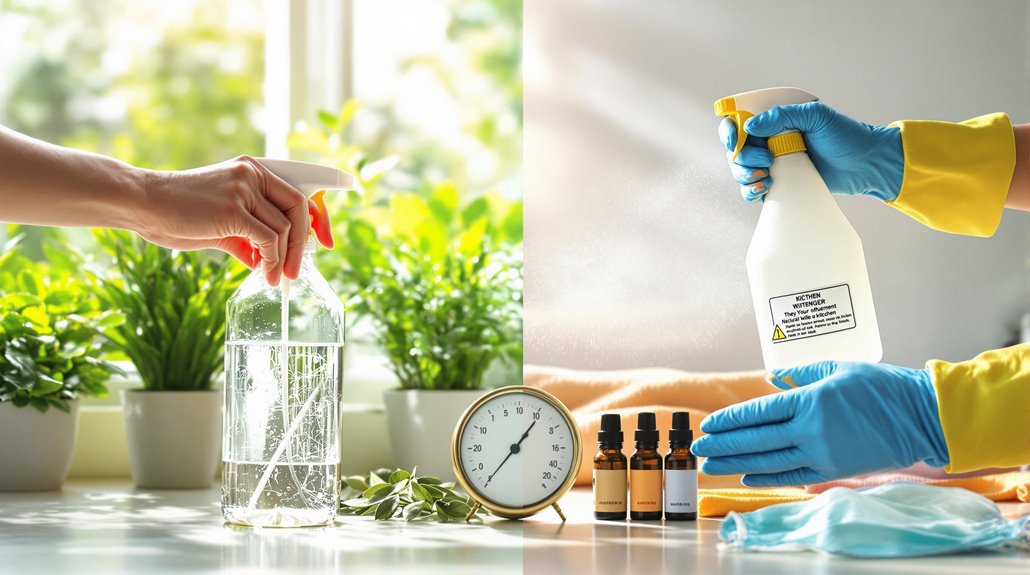
When addressing mold infestations, property owners must carefully weigh the merits of natural versus chemical remediation methods.
Natural solutions, which promote eco friendly cleaning practices, utilize ingredients like white vinegar, which effectively combats 82% of mold species, and essential oils with proven antimicrobial properties.
While these methods are environmentally safe and often less expensive, they may require multiple applications for ideal results.
Chemical treatments, particularly quaternary ammonium compounds (quats), offer robust solutions for severe infestations.
These EPA-registered products demonstrate higher efficiency in large-scale remediation but may present risks of material corrosion and skin irritation.
Among essential mold prevention tips, proper ventilation and protective equipment are vital regardless of the chosen method.
Both approaches require monitoring humidity levels with a hygrometer and addressing underlying moisture sources.
The selection between natural and chemical methods should consider infestation severity, surface type, and environmental impact while maintaining strict safety protocols.
Top Natural Remedies for Mold Removal
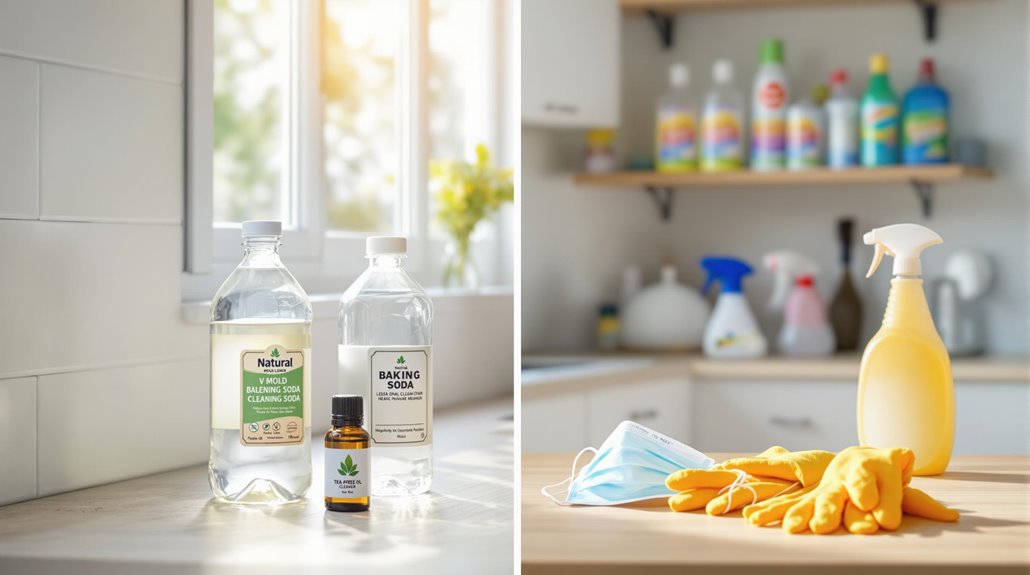
Natural remedies offer effective, environmentally conscious solutions for addressing residential mold problems. Among the most potent natural antifungal solutions, vinegar stands out with its ability to eliminate 82% of mold species when applied undiluted.
Tea tree oil and grapefruit seed extract, when properly diluted with water, provide powerful alternatives in mold resistance strategies.
Baking soda serves multiple functions in mold treatment, combining moisture absorption properties with gentle scrubbing action while deodorizing affected areas.
For enhanced effectiveness, hydrogen peroxide at 3% concentration delivers both antimicrobial and disinfectant properties. When implementing these remedies, proper safety protocols remain essential, including protective gear and surface testing.
Each solution requires specific application methods: vinegar needs 15-60 minutes of contact time, tea tree oil requires one hour, and hydrogen peroxide demands 10 minutes before scrubbing.
Follow-up treatments and preventive applications help maintain mold-free environments long-term.
Chemical Solutions and Their Effectiveness
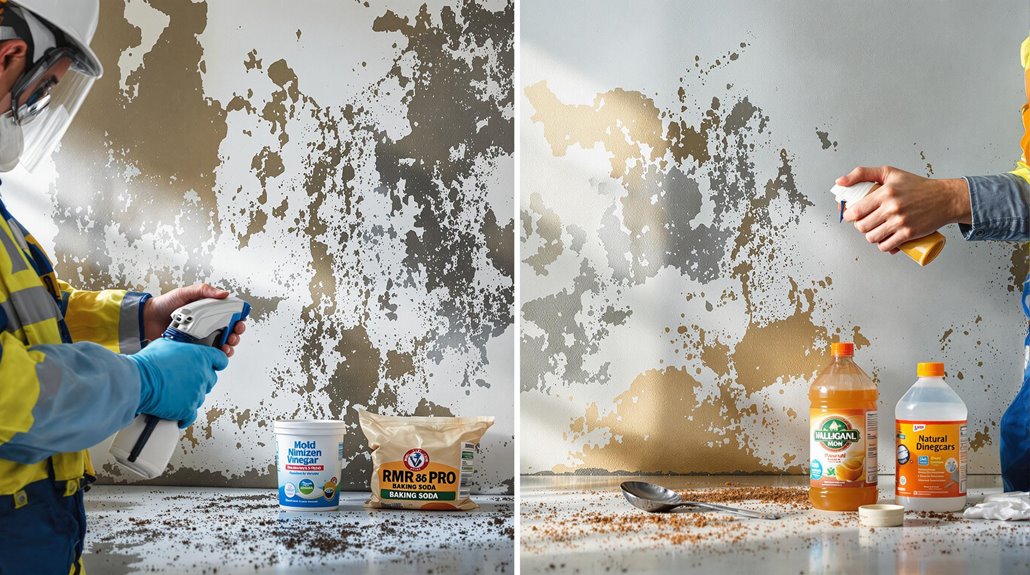
Chemical solutions for mold remediation require careful consideration of both effectiveness and safety factors. While bleach has traditionally been used, its limited chemical efficacy on porous surfaces and potential mold toxicity risks have led professionals to seek alternatives.
The high water content in bleach can actually contribute to mold growth in porous materials, making it less suitable for thorough remediation.
Quaternary ammonium compounds (Quats) represent a more advanced chemical approach, offering broad-spectrum effectiveness through cell membrane disruption. Products like RMR-86 PRO provide fast-acting results, while Concrobium Mold Control offers a non-toxic alternative that physically eliminates spores.
Hydrogen peroxide presents a middle-ground solution, effectively oxidizing mold on non-porous surfaces, though its use requires careful handling due to respiratory risks at high concentrations.
When selecting chemical solutions, considerations must include surface type, ventilation requirements, and proper protective equipment to guarantee safe and effective mold elimination.
Step-by-Step Guide to Using Vinegar and Tea Tree Oil
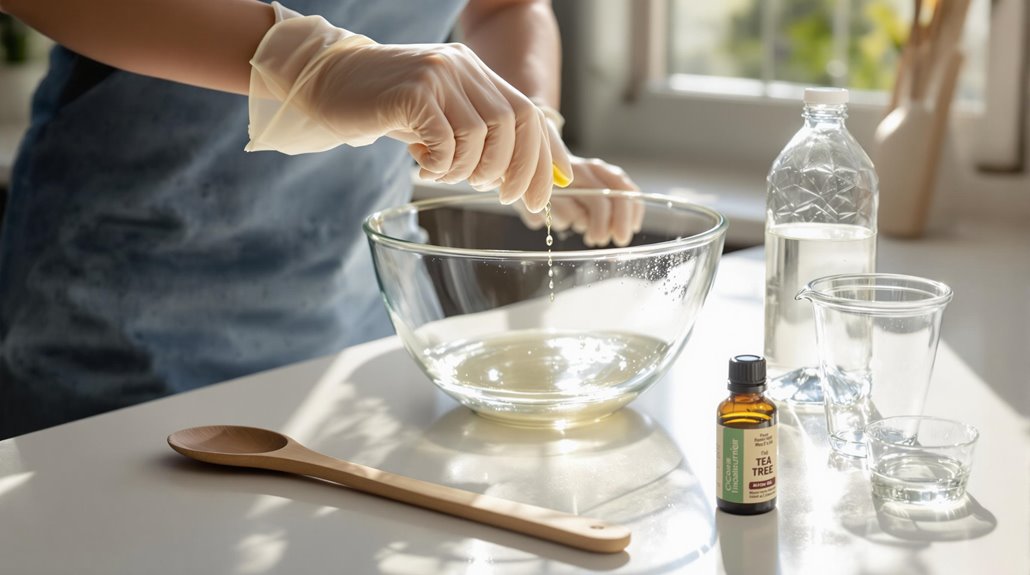
Both vinegar and tea tree oil serve as effective natural alternatives to harsh chemical solutions for mold removal, each offering distinct antimicrobial properties through different mechanisms of action.
Vinegar effectiveness stems from its acidic composition, requiring a 1:2 ratio with water for ideal results, while tea tree oil's fungicidal properties depend on specific concentrations of Terpinen-4-ol and Cineole.
The application process for both solutions follows similar protocols: preparation of the solution, direct application to affected areas, allowing sufficient contact time of one hour, thorough scrubbing, and complete rinsing.
For vinegar application, users should mix one part vinegar with two parts water. Tea tree oil requires 1-2 teaspoons mixed with two cups of water or vinegar.
Safety precautions are essential when using tea tree oil, including wearing protective gloves to prevent skin irritation. Both methods may require multiple applications for complete mold elimination, and professional intervention should be considered for extensive infestations.
Safe Application of Bleach and Fungicides
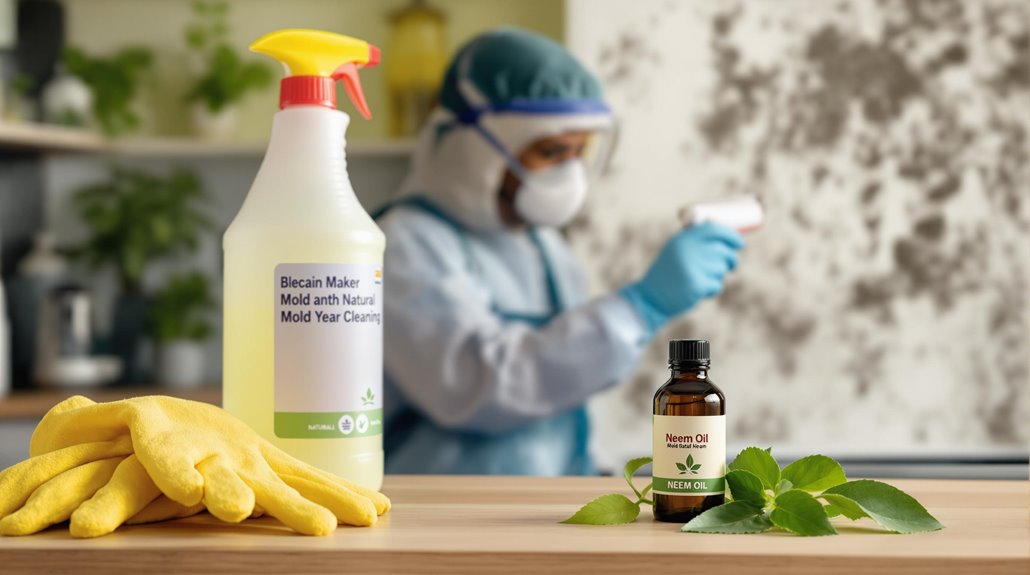
Proper handling of bleach and fungicides requires strict adherence to safety protocols and precise measurement ratios for effective mold elimination.
For bleach safety, users must maintain a 1:1 ratio of one cup bleach per gallon of water, while wearing protective equipment including rubber gloves and eye protection. The solution should remain on affected surfaces for 1-2 hours before scrubbing and thorough rinsing.
For fungicide effectiveness, homeowners can choose between chemical and natural options. Approved fungicides like chlorothalonil and neem oil-based products offer systematic control when applied according to label instructions.
Neem oil applications should follow a 7-14 day schedule, particularly during spring budding, with complete coverage of plant tissue. Application timing is essential, with early morning or late evening treatments recommended to prevent leaf damage.
For both bleach and fungicide applications, users must test products on small areas first and recognize when professional intervention becomes necessary for extensive mold infestations.
Prevention Strategies After Mold Removal
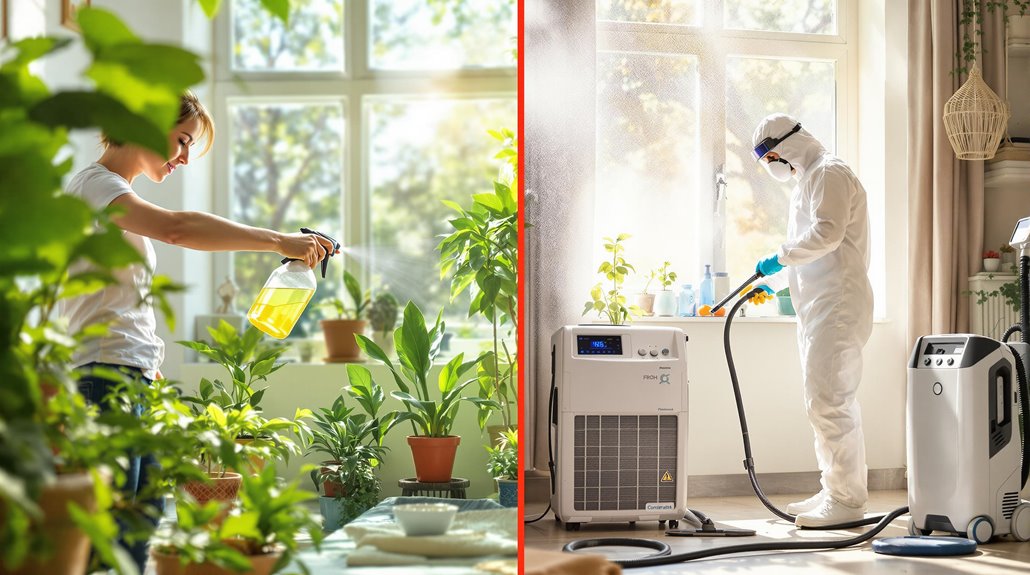
Successful mold remediation requires implementing thorough prevention strategies to maintain a mold-resistant environment. Long term strategies focus on environmental control and continuous monitoring to prevent mold recurrence. Vital measures include maintaining indoor humidity levels between 30-50% and guaranteeing proper ventilation in moisture-prone areas.
For effective mold prevention, property owners should implement these significant steps:
- Install dehumidifiers and hygrometers to monitor and control moisture levels
- Conduct regular inspections using moisture meters and thermal imaging cameras
- Maintain HVAC systems through routine cleaning and professional servicing
- Establish proper ventilation systems in bathrooms, kitchens, and laundry areas
Post-remediation safety requires systematic air quality assessments and continuous monitoring of previously affected areas.
Regular cleaning with HEPA-filter vacuums and prompt attention to water leaks are essential components of prevention. Property owners should address underlying moisture issues immediately and consider professional consultation for severe cases to guarantee long-term success in mold prevention.
Best Practices for Different Surface Types
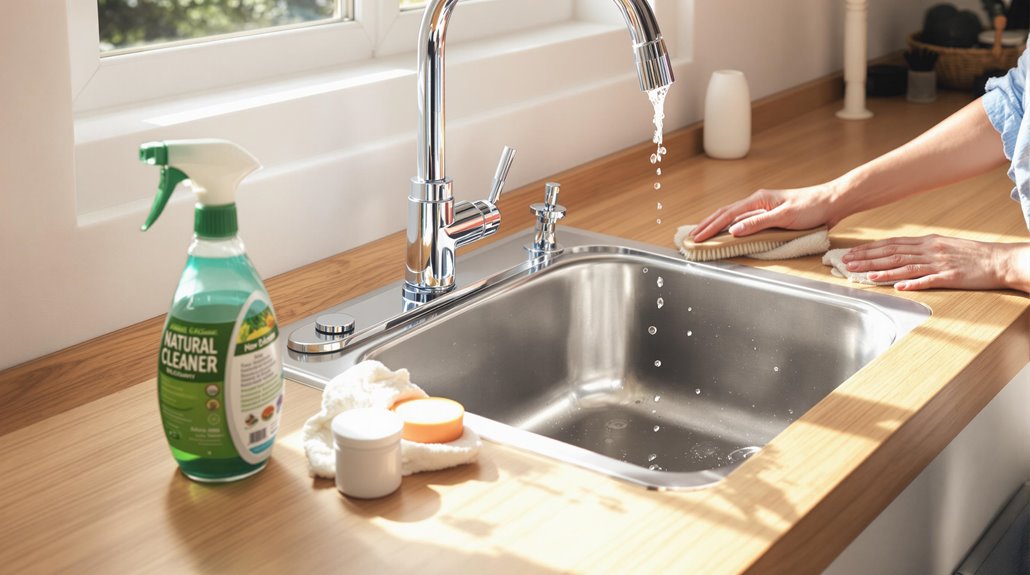
Different surface types require specific mold removal approaches, with hard surfaces typically being easier to clean than porous materials that may require complete removal and replacement.
Wood surfaces demand careful attention to prevent structural damage, often needing gentle cleaning methods and thorough drying to maintain integrity.
Metal surfaces generally respond well to standard cleaning procedures, but proper drying and surface treatment are essential to prevent rust and future mold growth.
Hard Vs Porous Surfaces
When addressing mold growth in a home, the surface type determines the appropriate cleaning method and potential remediation approach. Surface cleaning methods vary considerably between hard and porous materials, with each requiring specific mold detection techniques and treatment protocols.
Hard surfaces like tile, glass, and metal respond well to detergent-based cleaning solutions and can typically be fully restored. However, porous materials present greater challenges due to deep-rooted contamination.
Consider these essential differences:
- Hard surfaces allow for direct scrubbing with detergent solutions, while porous surfaces may require specialized treatments.
- Porous materials often need replacement when heavily contaminated.
- Chemical cleaners are more effective on hard surfaces than on porous materials.
- Natural alternatives like vinegar work best on hard, non-porous surfaces where contact is direct.
Wood and Metal Care
Managing mold on wood and metal surfaces requires specific care protocols tailored to each material's unique properties and vulnerabilities.
For wood preservation, proper sealing with treatments like DDAC or borax solutions proves essential, while maintaining humidity levels below 60% through dehumidification and ventilation prevents moisture accumulation.
Regular cleaning with gentle solutions like dishwashing soap or distilled vinegar helps maintain wood surfaces.
Metal maintenance focuses on preventing condensation through proper insulation and ventilation.
Applying mold-resistant coatings and installing vapor barriers provides additional protection for metal surfaces.
Both materials benefit from systematic inspection routines, prompt leak repairs, and immediate drying of wet surfaces.
The key to successful mold prevention lies in combining appropriate cleaning methods with consistent moisture control measures, ensuring the longevity of both wood and metal surfaces.
When to Call Professional Mold Remediation
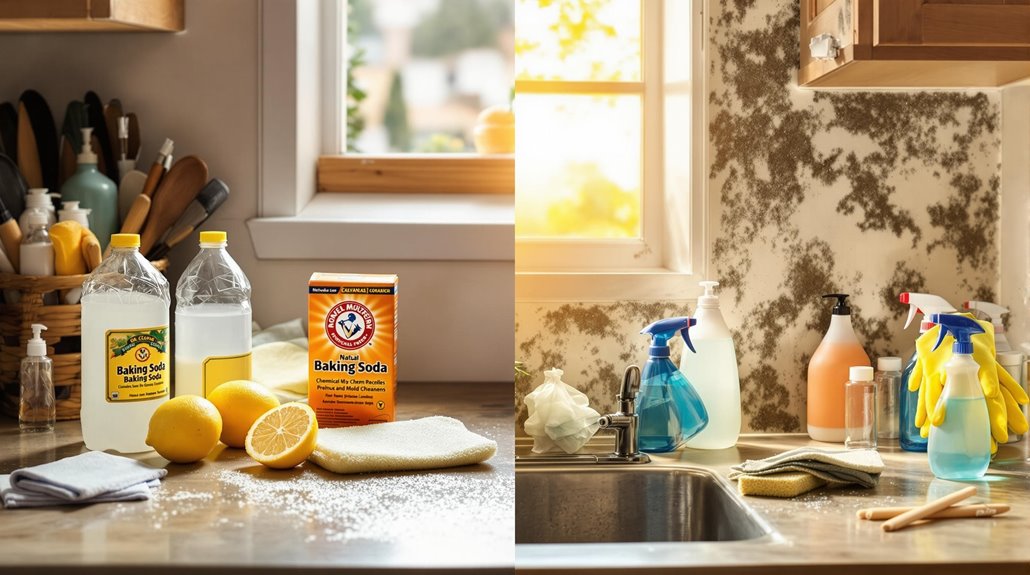
Professional mold remediation becomes necessary once certain critical thresholds are met or specific conditions arise in a home.
While mold remediation costs may initially seem high, they prove more cost-effective than addressing extensive structural damage or health issues later. EPA guidelines specifically recommend professional intervention for infestations exceeding 10 square feet.
Key indicators that warrant professional remediation include:
- Persistent musty odors that remain after cleaning attempts
- Visible mold growth covering large areas or spreading across multiple surfaces
- Occupants experiencing respiratory issues or allergic reactions
- Failed DIY mold prevention strategies and recurring growth
Professional remediation services utilize specialized equipment like HEPA filtration systems and moisture meters to detect, contain, and eliminate mold effectively.
Their all-encompassing approach includes identifying moisture sources, implementing proper containment procedures, and establishing preventive measures to guarantee long-term protection against future infestations.
This systematic method guarantees thorough mold removal while protecting occupants' health.
Health and Safety Measures During Mold Treatment
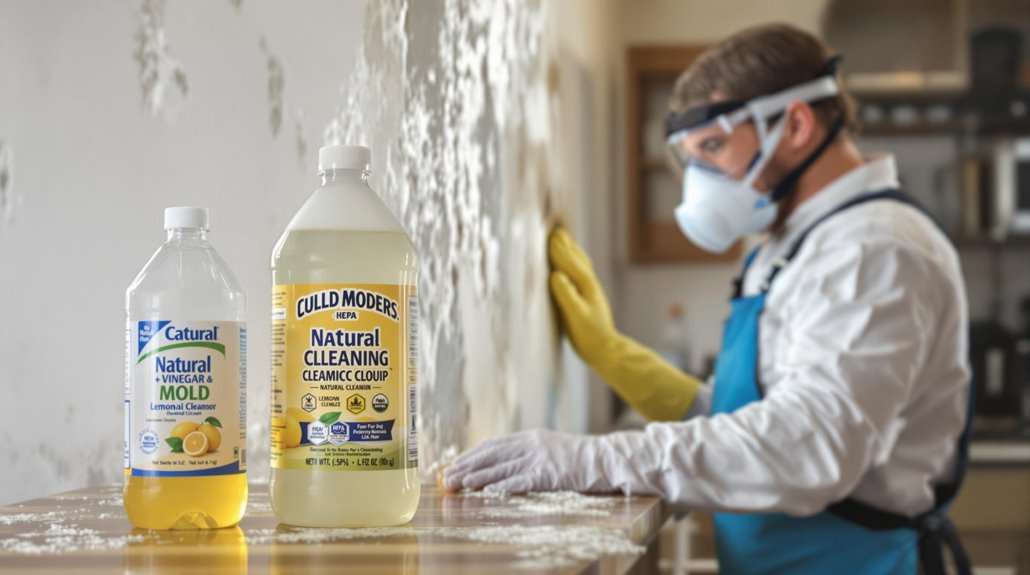
Safe and effective mold treatment requires strict adherence to thorough health and safety protocols to protect both occupants and remediation workers. The first critical step is isolating the affected area to prevent cross-contamination and restrict access to unauthorized personnel.
Proper protective equipment forms the cornerstone of mold safety. Workers must wear HEPA-filtered respirators, chemical-resistant gloves, and protective eyewear before entering contaminated spaces.
For extensive infestations, double-layer polyethylene barriers and decontamination chambers become necessary to maintain containment.
During treatment, specific practices must be followed to minimize spore dispersal. These include avoiding dry scraping, preventing HVAC system operation, and using appropriate cleaning methods for different materials.
All contaminated materials that cannot be salvaged must be sealed in bags and properly disposed of. Additionally, natural cleaning solutions should be considered to reduce exposure to harsh chemicals while maintaining effective remediation protocols.
The Benefits Of Consulting A Public Adjuster

Public adjusters provide specialized expertise in handling mold-related insurance claims, offering objective assessments of damage while ensuring thorough documentation of visible and hidden issues.
Their professional representation streamlines the complex claims process, eliminating common pitfalls and reducing the burden on homeowners during mold remediation procedures.
Statistical data indicates that claims handled by public adjusters typically result in considerably higher settlements, often securing three to five times more compensation than claims filed without professional assistance.
Expertise In Insurance Claims
When dealing with mold-related insurance claims, consulting a public adjuster can greatly improve the likelihood of receiving fair compensation for damages. Their expertise in insurance policy nuances and thorough understanding of mold coverage details enables them to navigate complex claim processes effectively.
Public adjusters provide critical expertise through:
- Detailed analysis of policy terms to identify all available coverage options
- Professional documentation of mold damage and associated losses
- Strategic negotiation with insurance carriers to maximize settlement values
- Expert identification of hidden damages that could affect long-term property value
Their specialized knowledge helps counteract common insurance company tactics aimed at minimizing payouts, while ensuring all necessary repairs are included in the claim.
This technical expertise often results in higher settlements compared to self-managed claims, making their services particularly valuable for complex mold-related cases.
Objective Damage Assessment
Securing an objective damage assessment through a public adjuster provides homeowners with extensive documentation and expert evaluation of mold-related property damage.
Public adjusters conduct thorough inspections alongside mold remediation specialists to identify both visible and concealed damage areas. This systematic approach guarantees accurate damage documentation for insurance claims, addressing immediate concerns and potential long-term issues.
During claim negotiations, public adjusters leverage their expertise to interpret policy language, understand coverage limitations, and identify all necessary repairs. Their specialized knowledge helps maximize claim settlements by properly documenting evidence and presenting detailed assessments to insurance companies.
The objective evaluation process also reveals hidden costs and secondary damage that might otherwise go unnoticed, guaranteeing homeowners receive fair compensation for all mold-related damages.
Streamlined Claim Process
The engagement of a public adjuster initiates a streamlined claims process that notably enhances the efficiency of mold damage resolution. Their expertise streamlines documentation, automates filing procedures, and guarantees thorough management of mold insurance claims. Public adjusters leverage advanced workflows to minimize errors while expediting settlements.
Key benefits of their systematic approach include:
- Professional documentation and assessment of mold-related damage
- Automated filing systems that prevent processing delays
- Expert negotiation with insurance carriers to secure fair compensation
- Thorough management of paperwork and deadline compliance
This streamlined approach considerably reduces policyholder stress while maximizing claim outcomes.
Public adjusters handle all communications with insurance companies, allowing property owners to focus on remediation efforts while guaranteeing their claims process progresses efficiently and effectively.
Higher Claim Payouts & Settlements
Professional engagement of a public adjuster greatly increases the likelihood of obtaining higher insurance claim payouts for mold-related damages. Their specialized expertise in damage assessment and policy interpretation enables the implementation of effective claim strategies that maximize settlements.
| Claim Aspect | Public Adjuster Impact | Result |
|---|---|---|
| Damage Assessment | Thorough documentation | Complete coverage |
| Policy Review | Expert interpretation | Maximum benefits |
| Negotiation | Strategic advocacy | Higher settlements |
| Documentation | Professional preparation | Faster approval |
Public adjusters leverage their extensive understanding of insurance policies and procedures to guarantee all damages are properly identified and valued. Their expertise in negotiating with insurance companies, combined with their knowledge of industry tactics, consistently leads to higher settlements compared to policyholder-managed claims.
About The Public Claims Adjusters Network (PCAN)
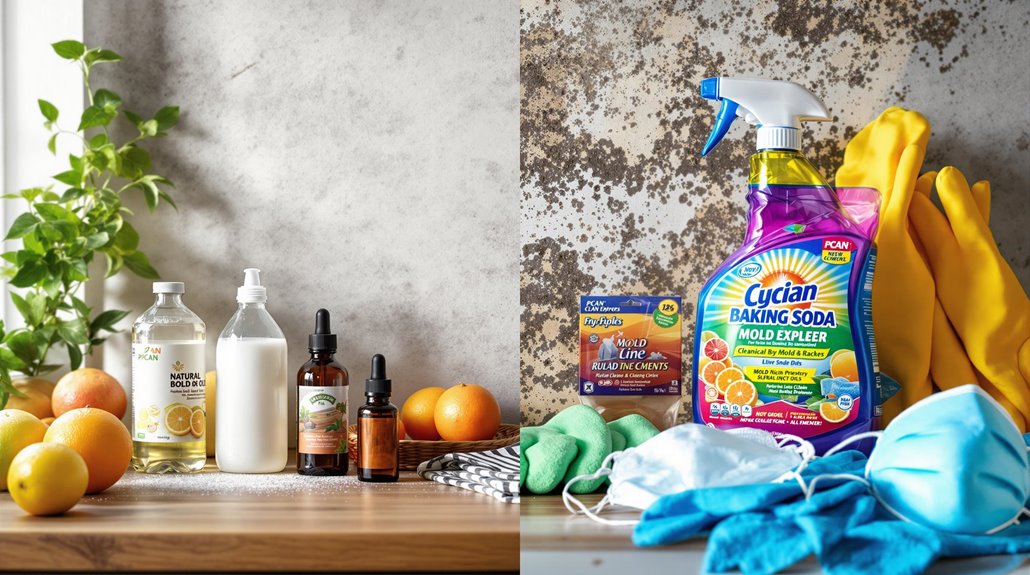
Public Claims Adjusters Network (PCAN) serves as a critical resource for homeowners dealing with mold-related insurance claims and property damage assessments. These trained professionals specialize in evaluating property damage, interpreting complex insurance policies, and managing the claims process to guarantee fair settlements for policyholders.
PCAN's thorough approach includes:
- Thorough inspection of visible and concealed mold damage through professional assessment protocols
- Expert interpretation of insurance policy coverage and exclusions related to mold remediation
- Complete documentation and submission of claims with supporting evidence
- Strategic negotiation with insurance companies to maximize claim settlements
Public adjusters navigate the intricate process of insurance claims while providing essential support throughout all phases. Their expertise typically results in higher claim payouts and more efficient processing times compared to self-managed claims.
PCAN's systematic approach helps homeowners understand their rights and guarantees all aspects of mold-related damage are properly documented and addressed.
Frequently Asked Questions
Can Indoor Plants Help Prevent Mold Growth in Humid Areas?
Air purifying plants effectively assist in mold prevention through natural humidity control. Species like Peace Lily and English Ivy absorb excess moisture and filter airborne mold spores in humid environments.
How Long Should I Wait Before Painting Over a Previously Moldy Surface?
After complete mold removal and surface preparation, wait 24-48 hours following cleaning and drying. Apply mold-resistant primer first, ensuring zero moisture remains before proceeding with paint application.
Does Air Conditioning Reduce or Increase the Likelihood of Mold Formation?
Properly maintained air conditioning systems reduce mold formation through effective humidity control and airflow management. However, poorly maintained units can increase mold risk due to moisture accumulation and insufficient ventilation.
Are There Specific Seasonal Patterns When Mold Problems Are More Common?
Mold growth patterns intensify during spring and summer due to increased humidity and temperatures, while autumn's decaying vegetation and winter's indoor condensation create distinct seasonal humidity effects favoring microbial proliferation.
Can UV Light Exposure Effectively Eliminate Mold in Hard-To-Reach Spaces?
Like playing hide-and-seek with microscopic foes, UV effectiveness in hidden spaces remains limited. Direct exposure is essential for killing mold spores, making treatment challenging without proper equipment and positioning.
Final Thoughts
Like a resilient warrior against the dark forces of mold, successful remediation requires a systematic, informed approach. Whether choosing natural solutions or chemical treatments, proper safety protocols and thorough application methods remain paramount. For extensive infestations, professional intervention through qualified remediation specialists or public adjusters guarantees all-encompassing treatment and potential insurance coverage, safeguarding both property value and occupant health.
For homeowners facing mold-related property damage covered under their homeowners insurance policy, insurance industry professionals and legal experts strongly advise consulting a qualified state-licensed public adjuster. These licensed professionals work exclusively for policyholders, not insurance companies, serving as dedicated advocates throughout the claims process. Public adjusters possess the expertise to identify hidden damages often unknown to policyholders yet covered by their policies, thoroughly document losses, and negotiate effectively with insurance companies to secure fair settlements while protecting policyholder rights.
The benefits of hiring a public adjuster include maximized claim payouts, expedited claims processing, and reduced stress during insurance negotiations. Homeowners dealing with mold damage can request a no-obligation free consultation with a Public Claims Adjusters Network (PCAN) member public adjuster to ensure their insurance claim receives proper handling and maximum compensation under their policy terms.
References
- https://www.ecofmr.com/articles/getting-rid-of-mold-naturally-non-toxic-diy-mold-remover/
- https://www.angi.com/articles/how-to-learn-how-kill-mold-naturally.htm
- https://extension.uga.edu/publications/detail.html?number=C1047-2&title=removing-mold-in-your-home
- https://www.grove.co/blog/how-to-clean-mold-mildew
- https://idryrestorations.co.nz/the-benefits-of-using-eco-friendly-mold-remediation-methods/
- https://www.webmd.com/lung/mold-mildew
- https://www.maids.com/blog/3-non-toxic-ways-clean-mold-natural-cleaners/
- https://www.epa.gov/mold/can-mold-cause-health-problems
- https://www.epa.gov/mold/brief-guide-mold-moisture-and-your-home
- https://www.niehs.nih.gov/sites/default/files/health/materials/mold_508.pdf



